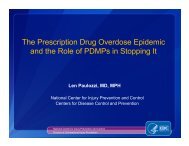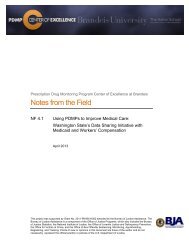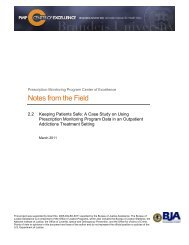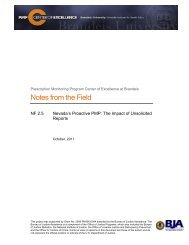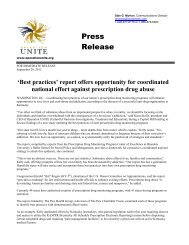Prescription Drug Monitoring Programs - PDMP Center of Excellence
Prescription Drug Monitoring Programs - PDMP Center of Excellence
Prescription Drug Monitoring Programs - PDMP Center of Excellence
Create successful ePaper yourself
Turn your PDF publications into a flip-book with our unique Google optimized e-Paper software.
<strong>Prescription</strong> <strong>Drug</strong> <strong>Monitoring</strong> <strong>Programs</strong>: An Assessment <strong>of</strong> the Evidence for Best Practices 12A. Standardize data fields and formats across <strong>PDMP</strong>sCurrently, <strong>PDMP</strong>s vary in the data fields and formats collected from pharmacies, limiting thecomprehensiveness <strong>of</strong> data, comparability <strong>of</strong> data across states, and ease <strong>of</strong> integration with prescriptioninformation collected by potential <strong>PDMP</strong> collaborators, such as Medicaid, the Indian Health Service (IHS),Department <strong>of</strong> Veterans Affairs (VA), and Department <strong>of</strong> Defense (DoD).1. Collect data on all schedules <strong>of</strong> controlled substancesRationale: A possible best practice in data collection, widely adopted but not universal among <strong>PDMP</strong>s, isto collect prescription history information on all classes <strong>of</strong> controlled substances (Schedules II-‐V). Thispractice is included in the Alliance <strong>of</strong> States with <strong>Prescription</strong> <strong>Monitoring</strong> <strong>Programs</strong>’ PMP Model Act(ASPMP, 2010) and will permit prescribers and pharmacists to examine the full spectrum <strong>of</strong> controlledsubstance prescriptions when making clinical decisions about patients. Although opioids are perhaps themost widely abused and diverted drugs, drugs in all schedules have abuse potential. For example, by2009, there were almost as many emergency department visits associated with misuse or abuse <strong>of</strong>benzodiazepines (373,200) as for opioids (393,200) (SAMHSA, 2010), and persons who are seriouslyabusing drugs frequently abuse multiple controlled substances (SAMHSA, 2011). Moreover, suspectedquestionable activity (e.g., doctor shopping) is associated with being prescribed multiple classes <strong>of</strong>drugs. <strong>PDMP</strong>s not tracking all classes will likely underestimate the prevalence <strong>of</strong> doctor shopping (Wilseyet al., 2010) and thereby fail to inform all affected providers about problematic prescribing anddispensing. BJA has designated collecting data on all schedules a priority for <strong>PDMP</strong>s seeking fundingunder its Harold Rogers Grant Program.Evidence <strong>of</strong> effectiveness: A preliminary evaluation <strong>of</strong> Performance Measure Reports submitted byHarold Rogers grantee <strong>PDMP</strong>s to BJA suggests that states collecting Schedules II-‐V have lower rates <strong>of</strong>doctor shopping than states collecting fewer schedules (<strong>PDMP</strong> COE analysis <strong>of</strong> Performance MeasureData, 2011).Current adoption status: According to the Alliance <strong>of</strong> States with <strong>Prescription</strong> <strong>Monitoring</strong> <strong>Programs</strong>, <strong>of</strong>46 states that have established reporting requirements, only 29 require reporting <strong>of</strong> Schedules II-‐V; seepmpalliance.org/content/state-‐pr<strong>of</strong>iles-‐reports.Barriers to adoption: Tracking all drug schedules involves updating data collection systems and the needfor regulation and/or legislation changes.SummaryRationale: Prescribers need to examine all scheduled drug classes to make proper prescribing decisions;all classes are subject to abuse; collecting all schedules permits improved detection <strong>of</strong> questionableactivity.Evidence <strong>of</strong> effectiveness: Unpublished <strong>PDMP</strong> COE data analysis, expert opinion (ASPMP Model Act).Current adoption status: 46 states have established reporting requirements; 29 require reporting <strong>of</strong>Schedules II-‐V.Barriers to adoption: Costs <strong>of</strong> updating systems, requires legislative and/or regulatory change.



